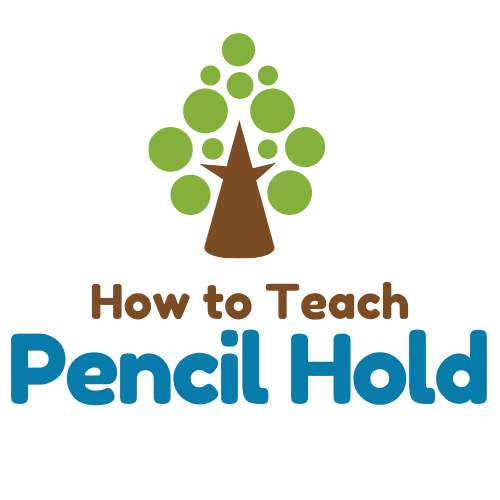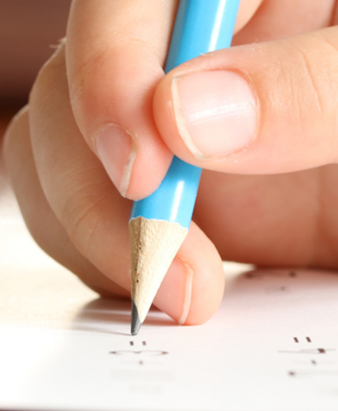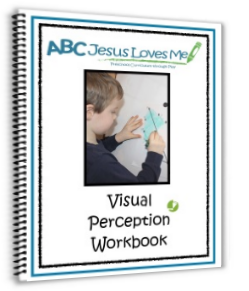
Teaching a child the proper pencil grip is essential for writing success. A correct grip helps a child write with more control, comfort, and efficiency, preventing strain or fatigue during writing tasks. By learning the correct way to hold a pencil early on, children can build the foundation for neat handwriting and strengthen their hand muscles for future academic tasks. Below are tips and strategies to help guide your child in mastering proper pencil grip.
Just as learning to walk is a building process, there are several stages of a pencil grip before the child is ready for the three-finger grasp. The good news is that normal development in the child's fine and gross motor coordination naturally progresses the child through each stage. And the ABCJesusLovesMe Curricula walk the child and adult through the development process at an age-appropriate manner.
1 to 2-year-olds: Fist Grasp (Large Movements)
A toddler uses a fist or palm grasp to hold a writing utensil. The thumb is on top and the shoulder initiates the movement. Random scribbles are large and uncoordinated. For this age, I suggest jumbo crayons or short colored pencils, or egg crayons. Do not use markers or pens as the use of them does not build muscle strength.
2 to 3-year-olds: Palmar Grasp
During this time, the child will rotate the thumb to the bottom of the grasp. Elbow and arm movements will guide the writing tool. Occupational therapists have discovered that broken crayons (1” in length) force a child to correctly hold a writing utensil so no bad habits are developed.
3-year-olds and Beyond: Tripod Grasp (Small Movements)
With proper muscle strength, the child will move toward the desired tripod grasp. The pencil or crayon is pinched between the thumb and index finger while supported on the middle finger. The 3 and 4 Year Curricula suggest using broken crayons or short pencils to assist in using the correct grasp.
The child’s fine and gross motor skills must be appropriately strengthened in order for the child to properly hold a pencil. Swiping on a tablet or pointing on a smart phone does not provide the necessary muscle development. If the child hates handwriting activities, it is typically because it is hard and the fingers do not have the required strength. Thus, continue to work on fine motor activities (small muscle movement like in the fingers) and gross motor activities (core strength) to increase the child's motor control. If concerned, seek professional help.
Then as the dexterity improves, try handwriting activities again. Occupational therapists have discovered that broken crayons (under 1” in length) force a child to correctly hold a writing utensil so no bad habits are developed.

After the fine and gross motor coordination is in place, the first step to nice handwriting is a correctly held pencil. Again, the correct hold is debated but most professionals believe the tripod grasp is the desired grasp. The tripod grasp uses the thumb and pointy finger to hold the pencil while the pencil rests on the middle finger. Some children will distinctively hold the pencil correctly. Just watch that it doesn't change at some point.
When the child is ready to graduate from broken crayons to short pencils, teach the child to hold the writing utensil with his thumb and index finger while supporting it on the middle finger. This following teaching techniques work for both right and left-handed children.
Alligator Mouth - Tell the child to make an alligator mouth with his thumb and index finger. Pinch the alligator's mouth onto the pencil. Then let the alligator go to sleep and rest the pencil on the middle finger and the crest between the thumb and index finger.
Pencil Flip - Lay a pencil front of the child with the point facing toward her. Ask the child to pinch it with her thumb and forefinger about 1/2-3/4" from the end. Pick it up and flip the pencil back onto her hand. Support the underside of the pencil with the middle finger. This technique works with right and left handed children. idea shared by Lori
Tissue Hold - Place a rolled up tissue or small sponge in the child's palm. Have the child hold the tissue or sponge with his ring and little finger. Then, using a short pencil, help the child hold the pencil with their thumb and first finger and rest on the middle finger. Having to hold the tissue as well as the pencil will help the child maintain the correct form. I personally did not find this idea helpful for my kiddos, but I know those who have successfully used it.
 The Stetro Grips
The Stetro Grips helped my kiddos maintain a consistent correct hold.
Children learn to draw by copying. Start with lines and progress to simple shapes.
- Play “Draw What I Draw” and have the child draw what you draw and then reverse. Begin with lines and move to simple shapes.
- Give the child various shaped objects to draw around. You can also make shapes out of cardboard.
- Read the Learning to Write page for ideas of how to help a child learn to write letters and numbers.
-  The ABCJLM Visual Perception Workbook contain over 80 worksheets to help a child with drawing, writing, and visual perception training. Included in this book are mazes and dot-to-dot worksheets which help in pencil control,
The ABCJLM Visual Perception Workbook contain over 80 worksheets to help a child with drawing, writing, and visual perception training. Included in this book are mazes and dot-to-dot worksheets which help in pencil control,
- We have enjoyed the How to Draw books. Click to read more here.
This page may contain affiliate links. Please read our disclosure policy.